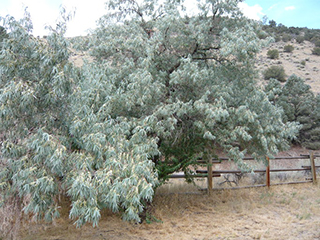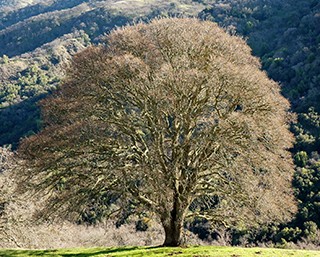 Elaeagnus angustifolia. Photo © Zoya Akulova.
Elaeagnus angustifolia. Photo © Zoya Akulova.
Russian olive (Elaeagnus angustifolia) is a perennial deciduous tree native to Europe and Asia. It was introduced to North America in the early 1900s as a landscaping tree because it was thought to be useful as a windbreak, soil stabilizer, and habitat provider. Unfortunately, Russian olive escapes cultivation easily, especially along riparian zones, and is invasive throughout much of California, as well as in 16 other western states. When Russian olive establishes in an area, it chokes out native plants and prevents them from re-establishing, and can be detrimental to the natural hydrology of riparian areas such as stream banks.
It is difficult to control Russian olive because the trees are deeply rooted and capable of re-sprouting from the root crown. To control an infestation, it is important to catch it early and remove trees before they flower. Established populations may require significant effort and several control techniques to eliminate.
Native Alternative
 Quercus lobata. Photo © Pete Veilleux.
Quercus lobata. Photo © Pete Veilleux.
Valley oak (Quercus lobata) is a deciduous tree native to the central valley of California. It provides habitat for birds and other wildlife, and is a great shade tree during the summer. In the Central Valley, it will grow up to about 100 feet tall.